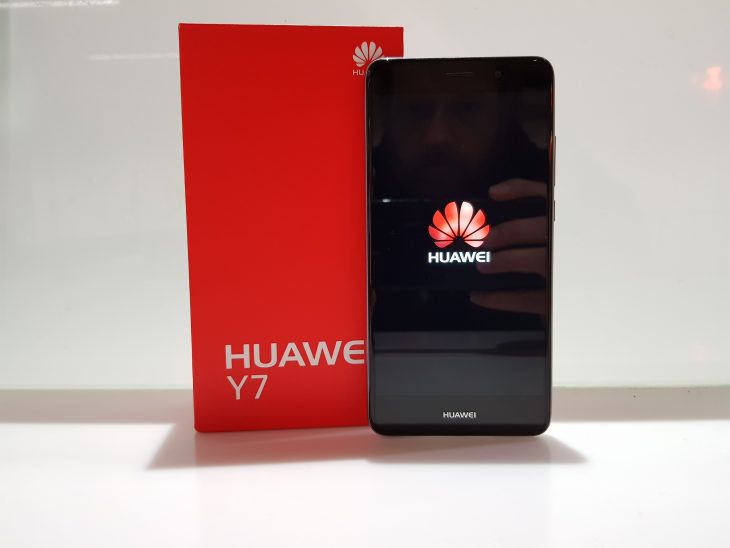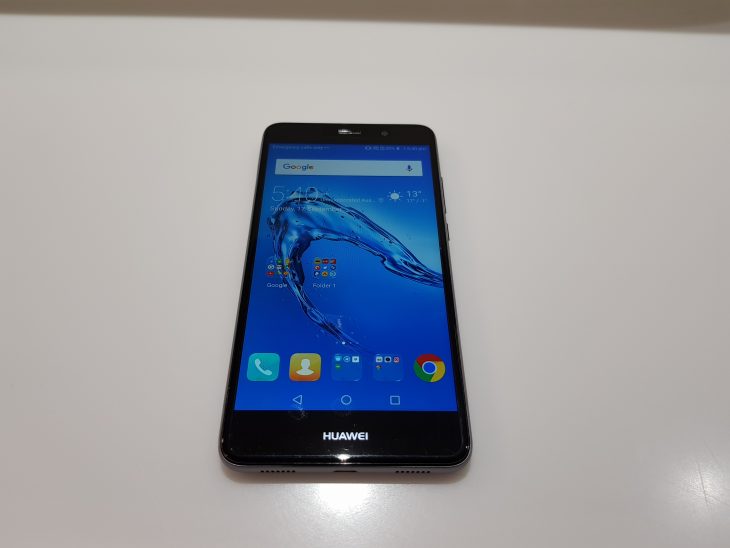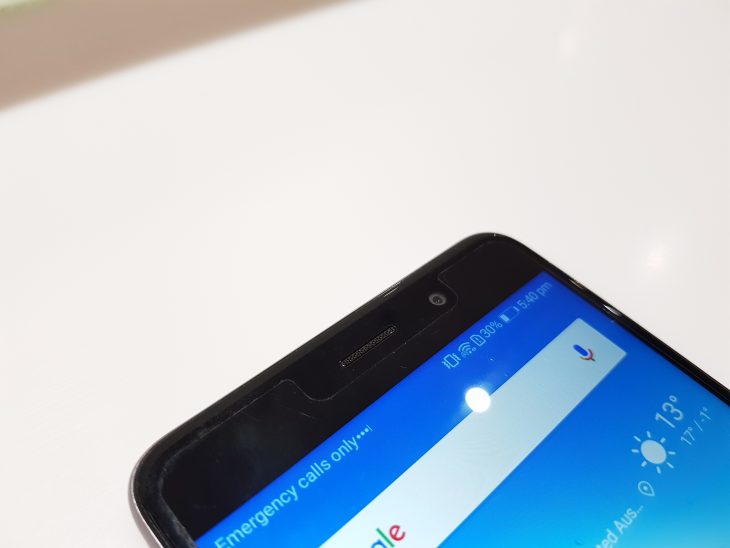
My first review for Ausdroid was a Huawei phone, all the way back in 2012. From those days, Huawei has very much exploded in terms of popularity and reach.
The Huawei Y7 is their 2017 mid-range device and priced at $299, it’s got some stiff competition with the Moto G5 Plus and Oppo A57 and more.
Huawei has built a solid reputation building great handsets packed with features for a low-cost, but rumours say that may change so is this a good mid-range handset to get from Huawei? Let’s find out.
What’s in the box?
The contents of the box isn’t actually very exciting for the Y7. You get your phone, a microUSB cable and charging brick as well as a pin to open the SIM tray….that’s literally it.
The disappointment for me was that there was no inclusion of a basic TPU case which has been a very welcome inclusion in other Huawei reviews we’ve done. There’s also strangely no earphones, though this could be a difference between the review device and the retail device. I’ve got a few thousand earphones, so no biggie.
What’s under the hood?
The Huawei Y7 is a pretty decent phone to look at, it starts with a 5.5” HD (1280×720) resolution IPS LCD display on the front. That spec though is fairly underwhelming when you look at the FullHD resolution displays on the competition though, that said it’s good enough when using it indoors and out with the IPS LCD giving good viewing angles.
The Huawei Y7 takes a step in the right direction from my perspective by packing in a Qualcomm Snapdragon 435 (MSM8940) processor as opposed to a Mediatek processor which they use in lower end Huawei handsets like the Y5. There’s nothing inherently wrong with Mediatek processors – but Qualcomm does seem to handle better. That said, it is a 400 series processor – again, nothing wrong with it, but we are seeing Snapdragon 625 processors in the competition.
The pairing of an SD435 SoC with 2GB of RAM and 16GB storage (8.13GB user available) with microSD Card slot is pretty standard at this end of the market, though the competition is starting to up the ante here as well with both the G5 Plus and A57 packing in 3GB of RAM and 32GB of storage.
Camera wise, the Huawei Y7 is also right up against it when you compare the specs. A 12MP sensor on the rear behind an f/2.2 aperture doesn’t sound super impressive, however it that sensor is 1/2.9″ with pixels measuring 1.25 µm so low-light photography in theory should be up to snuff. An 8MP sensor on the front with an f/2.0 rounds out the camera specs.
Internally you get all the connectivity options including Wi-Fi (unfortunately 2.4GHz only), Bluetooth 4.1 and GPS (including GLONASS). There’s no NFC in here unfortunately so if you want to use Android Pay or one of the banks custom Tap & Pay options you’re out of luck.
You do get an FM radio built-in, which Scott continuously tells me is a massive plus for a phone, I’m not as big a user of FM, but it’s there and it works.
Cellular connections are pretty much all here with FD-LTE Bands 1, 3, 5, 8, 28 and TD-LTE Band 40 for Optus’ 4G Plus network included. The embedded modem in the phone won’t blow you away, but it definitely gets the job done.
As well as wireless connections, you do get a 3.5mm jack. You’ll need to have headphones connected to make use of the aforementioned FM radio but for audiophiles the connection is there….even if the actual sound isn’t spectacular. In terms of speakers you get twin speaker grills at the bottom of the phone, but only one speaker (behind the right grill).
Surprisingly in this day and age of USB-C, Huawei are still using a microUSB connector on the Y7. A microUSB connector isn’t a huge deal at this end of the market, in fact with most people having multiple microUSB chargers by now, it’s actually helpful, just something to note.
The standout feature for the Huawei Y7 is the 4,000mAh battery which towers above the competition. A fairly handy power saving mode in software means the phone will, in theory, eke out a little more from each charge cycle.
What does it do well?
Huawei have been doing aluminium unibody designs for so long that they nail this easily. The 2.5D glass on the front of the screen curves gently around merging into the aluminium body with barely a seam, something not really found on most handsets in this range.
The 5.5” screen is in theory quite large, but the whole phone feels quite comfortable in the hand, letting you operate it one handed quite easily. Pairing this with some one-handed software tweaks means it’s quite a manageable phone even for people with smaller hands.
For once this year, I don’t have to talk about a phone being a fingerprint magnet. The Huawei Y7 has a metal, sandblasted surface on the rear which makes it very easy to grip, though a little cold in the Canberra winters.
The design does leave a little bit of bezel above and below the screen which is a little ‘last years design’ but I’m not overly concerned by this.
The inclusion of a screen protector is a positive takeaway, even if it’s not one of the ‘better’ tempered glass ones, the inclusion, pre-affixed means most people will have a much better experience overall. It’s quite obvious that there is a screen protector installed, the cut out is quite obvious, but it’s stuck on well enough.
I’m also pretty happy with the battery life on the Y7. It’s not using a high-end processor, the screen resolution is fairly low and this means there’s little actually drawing power. The battery lasted me happily for most of a day – from 6am till around 8pm before finally needing a charge. It’s not great, but for a phone in this range I’ll take it.
Huawei definitely get props for launching the Y7 with Nougat (Android 7.0) as a base though this is offset a little with Android hidden behind that EMUI 5.1 skin. An update during the review period did bring both a security patch (April to July), an improved camera experience and better SIM card management tools. So, though a little slow, Huawei are still delivering updates to the phone.
How is the Camera?
Huawei’s chops on cameras have been hit and miss. Their higher-end phones in the Mate and P-series range from good to phenomenal with some shots, while their low to mid-range devices seem to not get the attention from Huawei’s developers that they deserve. The Y7 is very much in line with this philosophy what it can do though is take a decent, if not spectacular shot.
Shots from the 12MP camera on the Y7 aren’t going to win awards for clarity or colour reproduction, but what it does do is a utilitarian shot – it’s good enough. That said, on occasion, if you upload photos to Google Photos, the resulting composite shots can be truly good.
The one drawback on the camera front is the shutter lag. It’s slow. Abnormally slow. I didn’t load a lot of my usual stuff onto the phone in terms of apps, so there wasn’t a great deal running in the background, but an average 1-2 seconds shutter lag was normal for the Y7. It’s something that can be addressed in an update hopefully.
How are the low-light shots? Check these out:
Just as the rear camera can take a good shot in the right conditions, the front facing camera can too. At 8MP it’s not terribly high resolution but the faster aperture makes for a slightly better shot in some circumstances – just don’t use the beauty mode as it can get quite aggressive.
The UI on the camera can be a bit difficult to navigate. The switches to turn Flash on/off and switch from front to rear camera is obvious, but the Beauty Mode and Filters can be a bit confusing. There’s no real menu, just buttons at the top of the UI.
Video offers options up to 1080P in 16:9 aspect ratio and it’s decent quality, so there’s no issues there.
What isn’t so good?
The Y7 does have some rough edges when it comes to both performance and software.
The SD435/2GB RAM combo doesn’t seem quite up to multi-tasking multiple apps. Using Pocket Casts to listen to podcasts while navigating using Google Maps made the phone both stutter and lag as well as heat up quite a bit, making that aluminium unibody heat up quite nicely to warm the hands here in Canberra.
The lag is quite pronounced, even without a full range of my usual apps installed I was left tapping my feet waiting for function to return after the system locked up. At one crucial point I pulled another phone out to take pictures due to the phone locking up for too long.
The Software, like many EMUI skins before has fallen far short of what I deem to be making a valuable change to what stock Android offers. In fact, the same issues we’ve run up against previously using EMUI, including turning off permissions for accessibility settings whenever it wants, and being a might bit aggressive when it comes to killing off ‘unused’ processes, are still present.
The killing of permissions for accessibility settings irked my ‘tater’ more than I thought it would. It was mainly in Last Pass where the option to draw over other apps was constantly turned off that I felt the pinch.
While we’re on Last Pass, having to re-enter a password rather than use fingerprint access – due to Huawei not including a fingerprint sensor on the Y7 – was annoying to say the least. How did we survive this long without fingerprint sensors? When the competition are all including fingerprint sensors, this is a major misstep.
EMUI also has a lot to answer for in terms of software usability and design.
The Huawei decision to not include an app drawer continues to baffle me. Huawei has previously modified EMUI to include an app drawer, but you won’t find one on the Y7 and, as you’ll see me saying time and time again, that’s annoying.
Folders are truncated with a 3×3 row of icons before swiping across to get to the next panel. The Quick Settings are modified from stock Android just enough to make it annoying with a single line of icons showing before needing to expand them, and the settings menu is, as usual, Huawei’s design which makes things a little harder to find for new users.
Included apps for the most part aren’t too bad, with a number of tools not included in the stock Android app install such as Sound Recorder and a fairly well laid out and feature rich File Manager.
Their theming engine is a bit of fun and can, if you work at it, hide a multitude of Huawei’s design sins, but for my money, if you buy one of these phones just install a third party launcher like Action Launcher or Nova for a much improved experience.
Should I buy One?
The story of the Y7 is very much told when looking at the competition. The competitors are, for the most part, currently offering more for either the same price, or just a little extra – more resolution, more memory, even more camera sensors – the only place the Y7 truly shines is the battery which is something.
Huawei can take pride in making great looking phones but they’re starting to feel the pinch of being at the top of the market with hungrier smartphone makers looking to offer what Huawei used to – more hardware for less.
While the Y7 is a great looking, and feeling handset, there’s just too much competition in this range. Huawei is obviously looking at the pricing, with places like Target dropping it to $249. If Huawei wants to drop the price to the sub-$200 range we’d be looking at a different story, there’s better options but it is hard to go past the Y7.























$199 at Australia Post 21/05/2018 to 10/06/2018.
This phone would be much better if it was 5″ in my opinion
Mine came with all accessories including case & earphones.
Better phone at it’s price point than the review or specs would have you believe.
None of its competitor handsets were available off the shelf in Brissie.
My previous handset was venerable Moto g.
*Dual SIM was a key selling point for me
“If Huawei wants to drop the price to the sub-$200 range we’d be looking at a different story, there’s better options but it is hard to go past the Y7.”
It’s $199 at JB-HiFI at the moment and it was $229 previously without being on special. I believe it launched at $299 but quickly dropped. I agree with you that at ~$300 there are better phones and it might be worth spending a bit more for a SD625 phone, but at $199 it’s a bit of a bargain and ticks a lot of boxes.
Cheers for the review.
Australia Post offers $199 from 21/05/2018 to 10/06/2018